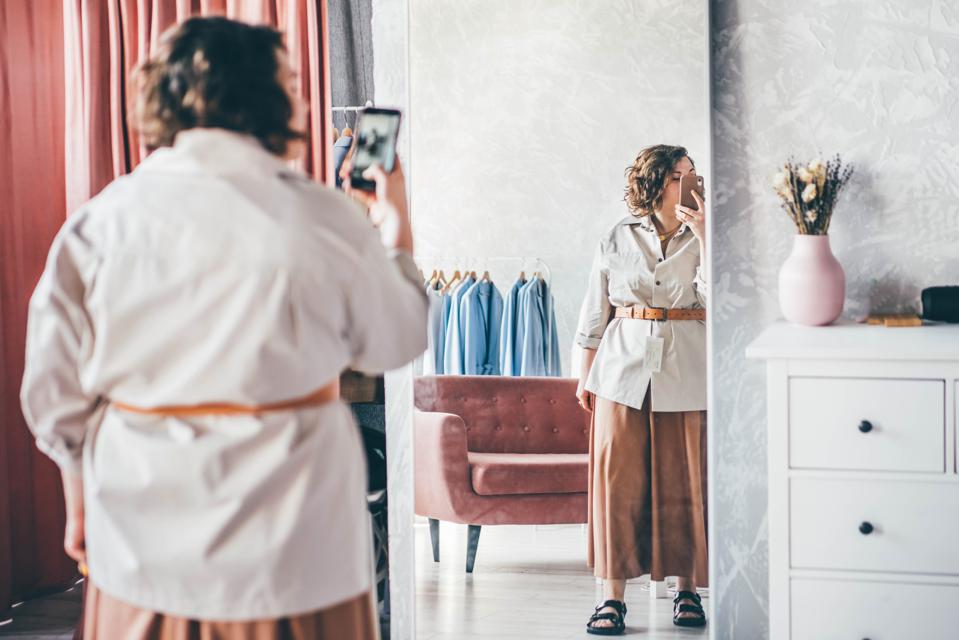The Fashion Institute of Technology (FIT) in New York City hosted “From Data to Design: Rethinking Fashion’s Approach to Plus Size Shoppers” last month. The event focused on research done by Mallorie Dunn, founder of inclusive-sizing company Smart Glamour and adjunct faculty at FIT. Funded by a President’s Diversity Grant for research, Dunn measured and interviewed 300 people with a waistline of 34 inches and above. At the event, she presented measurement data as well as data on shopping habits and attitudes she had gathered.
Dunn found that 55% of participants could only shop online based on their size, and most cited Target and Torrid as primary sources of clothing. She reported that the average participant had a 49.5 inch bust, a 45 inch waist, and 54.4 inch hips. “No matter what size you are, 80% of people do not fit specifically into size charts,” says Dunn. “Size charts are based on an hourglass body shape, but the overwhelming majority of people are not an hourglass shape.” Dunn says that inclusive sizing isn’t just a matter of fashion equity, it’s also a sustainability issue. ”If we continue to overproduce clothing for the minority of people, it’s obviously going to be thrown away. What if we just make clothes for the people that actually exist and divert a lot of waste?”
Dunn says her goal is to bring the inclusivity she championed with her company, Smart Glamour, to the fashion education system. She hopes this will greatly impact the fashion industry as a whole. The company was founded with the goal of addressing the exclusion of many people, but specifically plus-size people in the fashion industry. Dunn doesn’t shy away from discussing the emotional impact of the fashion industry’s refusal to accommodate the bodies of the majority of American women. “It’s not just about not having access to clothes, but what (mainstream fashion) imagery does to people’s psyches and how it makes them feel. I have a lot of conversations about how the fashion industry is set up to be detrimental to consumers, and it doesn’t have to be that way. There are other ways to run businesses.”
Before starting Smart Glamour, Dunn was in fashion school herself. “Going into school to learn about fashion design just really opened my eyes even more that the industry is run off of exclusion, and it never sat well with me,” shares Dunn. She says that while attending fashion school she would often talk with women, and she noticed that they often only had negative things to say about their bodies. During that time, Dunn began to synthesize what she was hearing and had some important realizations. “I (didn’t) want to participate in this. We are so much more than this, and also where did (we) even get this this notion that (our) bodies are inherently bad or wrong? I started thinking about where all that came from, and kind of connected it back in my mind to fashion imagery and advertisements. I just so badly wanted to do something to solve the problem.”
Dunn decided that in order to create solutions, she would need to step outside of her company and return to her roots. “I know that people who work in the fashion industry come from the fashion education system. I know that because I came from the fashion education system.” She wanted to inspire fashion design students to think critically about their industry, and be more inclusive and kind.
When she started teaching for continuing education at FIT, Dunn proposed her own course on inclusive fashion pattern-making. “I teach people to make clothes for all people,” says Dunn. From day one, students learn why creating patterns for a diversity of body types is important, and the realistic statistics of consumers. “Then the next two days (students) learn the technique of editing a pattern to fit any size person,” says Dunn. “We specifically edit the patterns to fit a plus-size fit model, but the technique can be used for any measurements. It’s not specifically for plus-size people. It’s how you edit a pattern to fit a specific person’s measurements.” The process continues with making a draft version of the design with muslin, that design being fit on a live model, and edits being made as needed. Finally, the garment is made again with the final fabric. “On the last day the same model comes back in, and they get to try it back on, and take pictures and videos.”
The presentation video and measurement data is now archived in FIT’s institutional repository where researchers, faculty, students, and fashion industry professionals will have access to it. Dunn says she hopes that her work will inspire others to be more inclusive in their designs.

